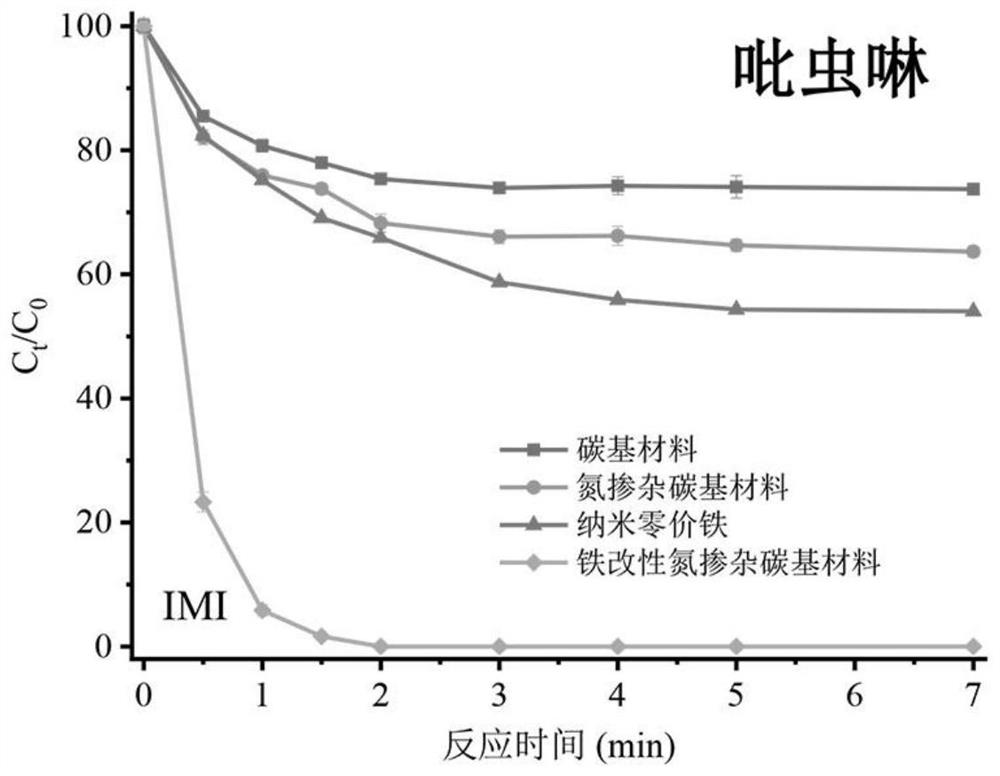A method for microwave-induced strengthening of iron-modified nitrogen-doped carbon-based materials for degradation of dyes and pesticides
A nitrogen-doped carbon and carbon-based material technology, applied in the field of environmental organic pollutant remediation, can solve the problems of reducing microwave energy utilization rate and pollutant degradation rate, weakening the non-thermal effect of microwave, etc., achieving good dispersion, promoting shedding, The effect of fast reaction rate
- Summary
- Abstract
- Description
- Claims
- Application Information
AI Technical Summary
Problems solved by technology
Method used
Image
Examples
Embodiment 1
[0038] Step 1: Synthesis of nitrogen-doped carbon-based materials
[0039] Using redox graphene carbon as the carbon-based material, 1 g of the carbon-based material was added to 200 ml of water, and then 1 g of melamine was added to form a mixed solution after 24 hours of adsorption equilibrium. Suction filtered and freeze-dried for later use. The resulting black mixture was transferred to an atmosphere furnace, and heated in a static state at 400° C. with nitrogen for 40 minutes at a heating rate of 5° C. / min. Then, the obtained black powder was washed three times with ethanol and deionized water, then suction-filtered, and freeze-dried for 24 h for further use.
[0040] Step 2: Preparation of iron-modified nitrogen-doped carbon-based materials
[0041] Place 1g / 200mL of the nitrogen-doped carbon-based material suspension prepared above in a three-necked flask, and fill 15g of FeSO 4 ·7H 2 O was added to the suspension and stirred for 12 hours to reach adsorption equilib...
Embodiment 2
[0045]Step 1: Synthesis of nitrogen-doped carbon-based materials
[0046] Using redox graphene carbon as the carbon-based material, add 1 g of the carbon-based material to 200 ml of water, then add 1 g of melamine, and form a mixed solution after 24 hours of adsorption equilibrium. Suction filtered and freeze-dried for later use. The resulting black mixture was transferred to an atmosphere furnace, and heated in a static state at 400° C. with nitrogen for 40 minutes at a heating rate of 5° C. / min. Then, the obtained black powder was washed three times with ethanol and deionized water, then suction-filtered, and freeze-dried for 24 h for further use.
[0047] Step 2: Preparation of iron-modified nitrogen-doped carbon-based materials
[0048] Place 2g / 200mL of the nitrogen-doped carbon-based material suspension prepared above in a three-necked flask, and fill 10g of FeSO 4 ·7H 2 O was added to the suspension and stirred for 12 hours to reach adsorption equilibrium, and 10g / 1...
PUM
 Login to View More
Login to View More Abstract
Description
Claims
Application Information
 Login to View More
Login to View More - R&D
- Intellectual Property
- Life Sciences
- Materials
- Tech Scout
- Unparalleled Data Quality
- Higher Quality Content
- 60% Fewer Hallucinations
Browse by: Latest US Patents, China's latest patents, Technical Efficacy Thesaurus, Application Domain, Technology Topic, Popular Technical Reports.
© 2025 PatSnap. All rights reserved.Legal|Privacy policy|Modern Slavery Act Transparency Statement|Sitemap|About US| Contact US: help@patsnap.com



